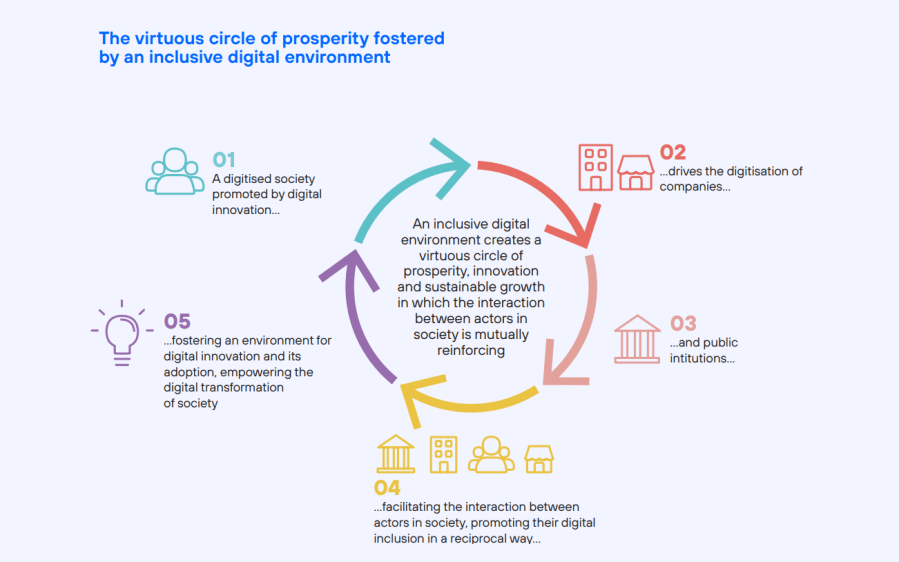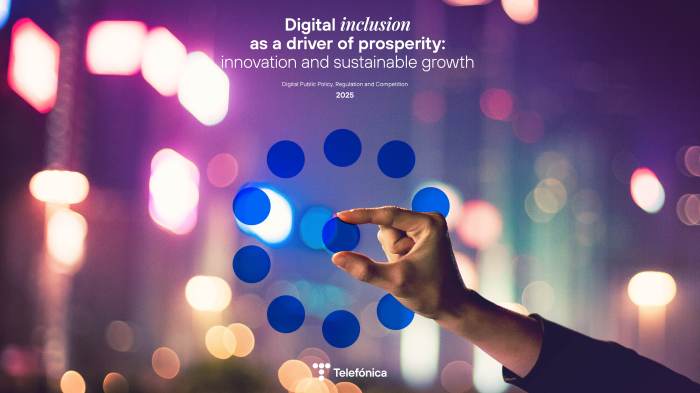Achieving prosperity in the 21st century goes beyond mere economic growth—it is about creating inclusive and sustainable development that integrates technological, social, economic, and environmental factors. In today’s digital economy, digital inclusion is essential for driving innovation, enhancing competitiveness, and strengthening economic resilience.
As the B20 emphasized, “closing digital gaps will drive economic resilience, empower SMEs, and foster innovation at scale.” Similarly, the OECD has linked digital inclusion with GDP growth, labor market participation, and industrial competitiveness; while ITU on its Regional Development Forum for Europe (RDF-EUR) 2025 this week will be addressing challenges and opportunities of digital inclusion.
Building on the foundation of Telefónica’s first paper on digital inclusion published in 2024, which focused on bridging coverage and usage gaps for individuals, this paper expands the usual scope of the debate to address a broader challenge: integrating all societal actors into the digital economy. This includes businesses of all sizes—large enterprises, SMEs, and microenterprises—public institutions, entrepreneurs, and the workforce. Achieving this broader vision requires a holistic strategy that fosters an inclusive digital environment by aligning digitization efforts across all societal actors, bridging digital divides, and promoting inclusive digital innovation.
Innovation and prosperity: The two go hand in hand
Technological progress and innovation are at the heart of prosperity. Digital innovation enhances productivity, competitiveness, and job creation, especially for SMEs.
However, despite its potential, its benefits are unevenly distributed, creating disparities. Development remains concentrated in large companies and digitally advanced countries, widening economic and social divides. Those slow to digitalize and innovate risk being excluded from key markets and opportunities and, ultimately from the digital economy, the economy of the 21st. century, deepening the prosperity gap.
A clear example of this is artificial intelligence or the startups ecosystems. In both cases, development is concentrated in a few digital advanced economies or companies, leaving other regions, like Latin America or smaller players at risk of falling behind.
Inclusive digital innovation first needs to expand a robust digital infrastructure. Studies show that a 10% increase in broadband penetration can boost GDP by up to 1.5%. Governments and private sector players must prioritize the expansion of high-speed connectivity, especially in rural and underserved areas.
However, connectivity alone is not enough. Inclusive digital innovations ecosystems further demand access to funding, skilled talent to drive transformative initiatives that fuel economic growth and employment, and supportive policies for smaller players or underserved regions. Public-private partnerships can democratize resources for startups, while regulations must foster competition and prevent market or innovation concentration. Finally, supporting green and ethical innovation ensures emerging technologies drive sustainable, equitable growth.
Beyond digital innovation, achieving a meaningful digital inclusion requires a holistic approach that fosters an inclusive digital environment, enabling individuals, businesses, and public institutions to fully leverage digital opportunities.

Digital inclusion of large business and SMEs
By integrating digitalization, companies boost productivity, upskill employees, and enhance customer experiences, reinforcing a dynamic and inclusive digital economy. However, digital inclusion must encompass all businesses, from micro-enterprises to large corporations.
McKinsey reports SMEs that adopt digital tools grow 26% faster and are twice as likely to engage in global trade. Yet, microenterprises and SMEs, which represent 90% of businesses worldwide, face barriers like limited access to funding, infrastructure, technology, digital skills gaps, or resistance to change—putting them at risk of exclusion.
On the other hand, large corporations foster inclusive digital growth by integrating SMEs into value chains, transferring knowledge, and investing in emerging markets, promoting broad digital adoption. However, the concentration of technological leadership in a few companies or countries creates a power imbalance allowing them to shape standards and decisions, which could lead to unequal, biased prosperity and widening inclusion gaps.
To ensure shared prosperity and avoid deepening economic disparities, we must provide financial incentives for digital adoption, encourage large companies to innovate, and ensure fair competition between large corporations and smaller players. Improving access to finance, supporting training, and open technology standards will help integrate SMEs into digital value chains.
The role of government in digital inclusion
Governments play a pivotal role in shaping the digital inclusion agenda. Beyond infrastructure and policy frameworks, they must also embrace digital transformation to improve efficiency and accessibility. The OECD’s Digital Government Index underscores the importance of proactive policies that promote digital accessibility, streamline public services, and integrate AI into governance. Modernizing public administration can enhance service delivery, simplify business operations, and enable more inclusive economic participation.
Public administration must evolve by digitalizing government services to simplify business registration, tax filing, and compliance. It should leverage AI and big data to enhance policymaking, resource allocation, and economic forecasting, while ensuring open data policies to foster business innovation. Additionally, developing strong cybersecurity frameworks is essential to protect both public and private sector digital assets.
Ensuring workforce readiness for the digital age
As the B20 Summit has highlighted, human capital is the foundation of digital transformation. However, an estimated 40% of workers lack the digital skills required for future jobs. The OECD warns that without proactive upskilling efforts, automation will increasingly replace low-skill jobs. By 2030, over 1 billion jobs will require significant digital proficiency, with advanced skills in AI, cybersecurity, and cloud computing becoming essential for high-income economies.
To address this challenge, we must scale digital training programs, ensuring they are accessible to all demographics. Partnerships between industries and educational institutions can ensure curricula meet the needs of the job market, while governments and businesses should co-invest in reskilling initiatives.
Digital inclusion is an economic necessity, not just a social ideal. Governments, businesses, and global organizations must unite to close the digital divide, as emphasized by the B20, OECD, and ITU, among others.
By investing in infrastructure, upskilling the workforce, supporting SMEs, empowering large companies, modernizing public administration, while promoting investment and innovation-friendly frameworks, we can drive sustainable growth and global competitiveness. In a global economy, digital inclusion is the pathway to shared prosperity, and only by embracing it can we ensure that everyone benefits from the digital economy.










